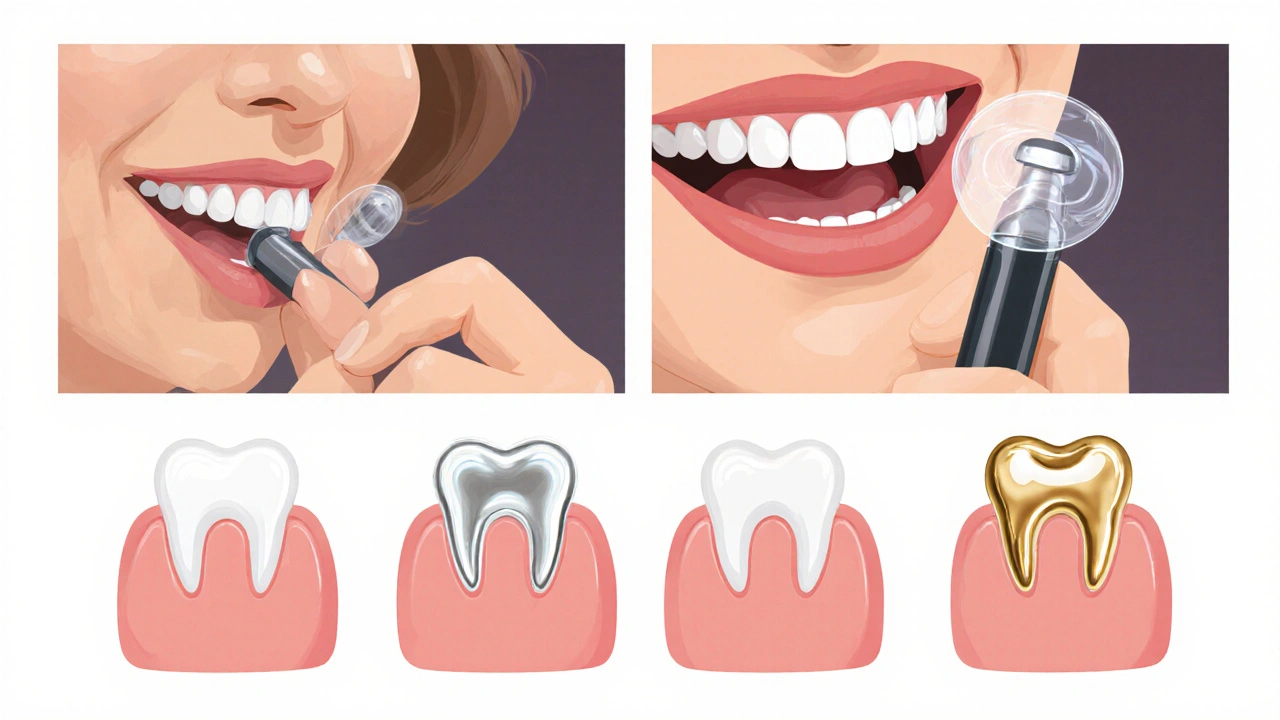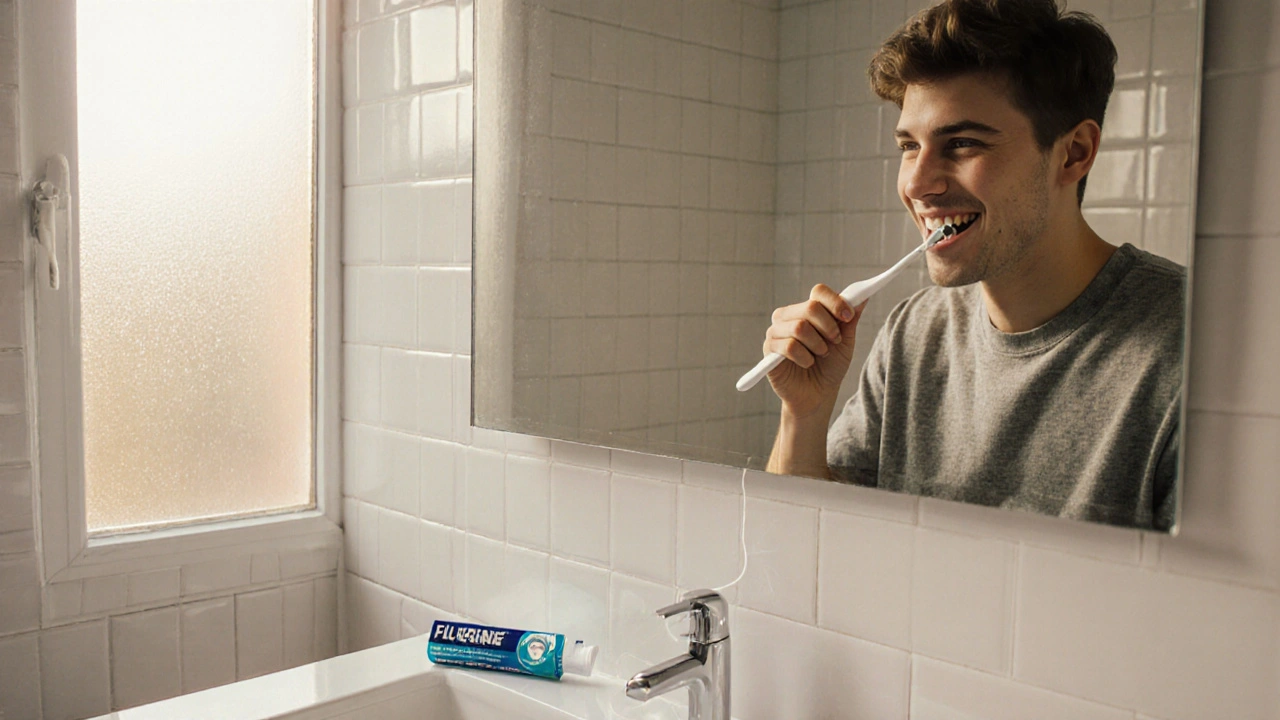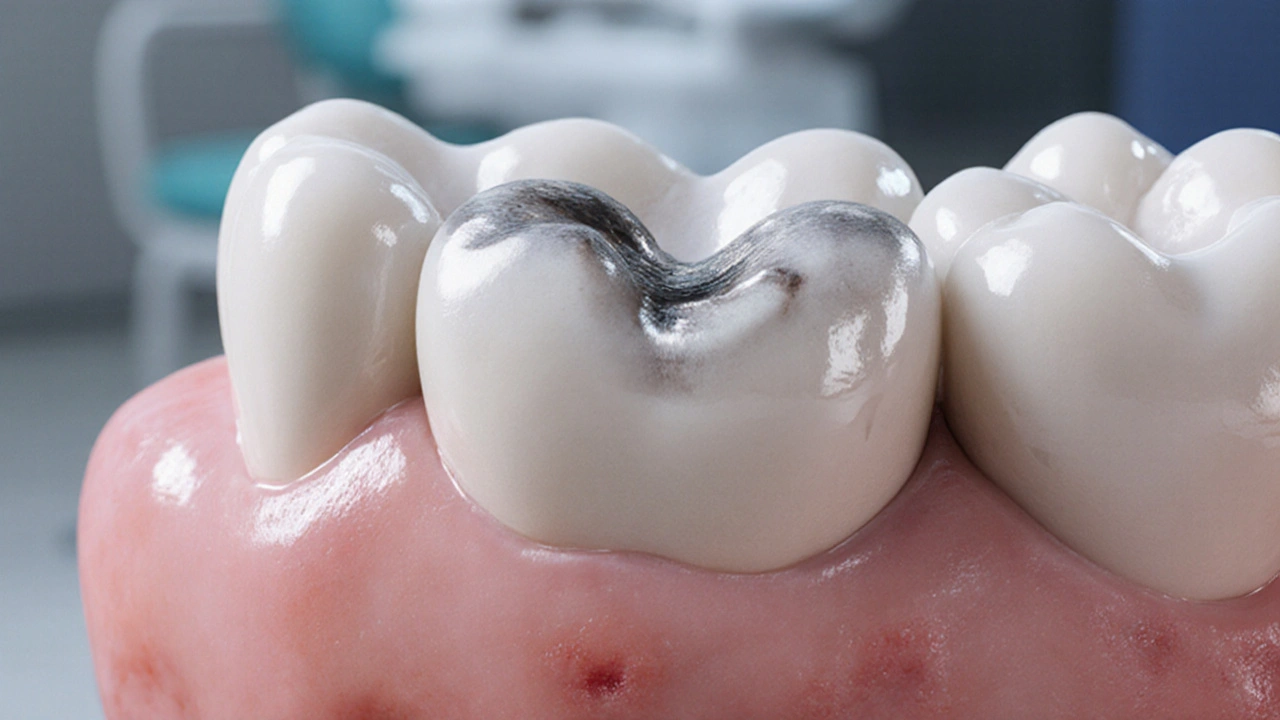Crown Material Selector
Select your top priority to find the best crown material for your needs.
Appearance
Choose this if natural-looking teeth are most important to you.
Durability
Choose this if long-lasting results are your main concern.
Cost
Choose this if budget is your primary consideration.
Recommended Crown Material
Key Considerations
Typical Cost (UK)
Expected Lifespan
Key Takeaways
- Tooth pain after a crown is often a sign of decay, a loose fit, or gum irritation.
- Different crown materials (porcelain, metal, all‑ceramic) affect comfort, appearance, and price.
- Immediate relief includes over‑the‑counter painkillers and cold compresses, but a dentist should evaluate persistent pain.
- Proper oral hygiene and regular check‑ups greatly reduce the risk of crown‑related problems.
- Understanding insurance coverage and long‑term costs helps you plan for a successful crown treatment.
When you notice a sudden ache after getting a new dental crown is a custom‑made cap that covers a damaged tooth, it can feel alarming. This guide walks you through why the pain happens, how crowns are placed, what to expect, and how to keep the problem from returning.
Why Toothaches Can Appear After a Crown
There are three common culprits:
- Toothache caused by lingering decay - If the original cavity wasn’t fully cleared, bacteria keep chewing away at the tooth beneath the crown.
- Improper fit - A crown that’s too high or too low puts pressure on the bite, irritating the tooth’s nerves and the surrounding gum.
- Gum irritation - The cement used to attach the crown can sometimes inflame the gum line, especially if it seeps underneath.
In rare cases, the pain signals a deeper issue like a cracked tooth or a need for a root canal. If the ache lasts more than a few days, it’s time to call your dentist.
What Happens During a Crown Procedure?
Understanding the steps helps you spot anything that went wrong:
- Preparation - The dentist files down the damaged tooth, leaving just enough room for the crown.
- Impression - An impression (digital scan or traditional mold) captures the exact shape of the trimmed tooth.
- Temporary crown - While the permanent crown is being fabricated, a temporary crown protects the tooth.
- Placement - Once the lab finishes the custom piece, the dentist bonds it with dental cement and checks the bite.
If any of these steps are rushed, the risk of post‑procedure pain rises.

Choosing the Right Crown Material
| Material | Appearance | Durability | Typical Cost (UK) |
|---|---|---|---|
| Porcelain‑fused‑to‑metal (PFM) | Natural look, metal core hidden | 10-15 years | £400-£700 |
| All‑ceramic | Highly translucent, best for front teeth | 5-10 years | £600-£950 |
| Gold crown | Metallic, not tooth‑colored | 20+ years | £800-£1,200 |
Each option balances looks, strength, and price. If you’re prone to grinding, a metal‑based crown may be kinder to your bite, while an all‑ceramic crown shines best for visible smiles.
How to Relieve Crown‑Related Pain at Home
Before you can see the dentist, try these quick fixes:
- Take an over‑the‑counter NSAID like ibuprofen (200‑400mg) every 6‑8hours, unless you have a contraindication.
- Apply a cold pack to the cheek for 15minutes, then rest for 15minutes - it reduces swelling.
- Avoid extremely hot or cold foods; temperature swings can aggravate a loose crown.
- Rinse with warm salt water (½tsp salt in 250ml water) to keep the area clean.
If the pain eases, it might have been simple irritation. Persistent throbbing, fever, or a feeling of “looseness” signals you need professional help.
When to Call Your Dentist
Schedule an appointment as soon as you notice any of these red flags:
- Sharp, lingering pain that doesn’t improve after 48hours.
- Swelling or pus around the crown.
- Visible cracks or chips in the crown material.
- Difficulty biting or a sense that the crown has shifted.
Your dentist will likely take an X‑ray, check the cement seal, and may need to replace the crown or perform a root canal.
Long‑Term Care and Maintenance
Keeping a crown pain‑free is mostly about good habits:
- Brush twice daily with a soft‑bristled toothbrush and floss around the crown to prevent gum disease.
- Use a fluoride toothpaste - it strengthens the underlying tooth.
- Avoid chewing ice, pens, or hard candy, which can crack the crown.
- Visit your dentist for a check‑up every six months; early detection of wear saves money.
Most crowns last a decade or more with proper care, but wear is inevitable. Knowing the signs early prevents painful emergencies.

Cost Considerations and Insurance
Understanding the financial side helps you avoid surprise bills:
- Standard NHS coverage in England typically includes a basic metal crown for molars, but aesthetic options are private.
- Private dental insurance often covers 50‑80% of the cost after the annual deductible.
- Ask for an itemised quote that lists the tooth preparation, the crown material, and the placement fee.
When budgeting, factor in the possibility of a second visit if the crown needs adjustment - that’s an extra £50‑£150 on top of the initial price.
Quick Checklist Before Leaving the Dentist
- Confirm the crown fits snugly and feels comfortable when you bite.
- Ask how long the cement will set - most need 24hours before heavy chewing.
- Get written after‑care instructions, especially if you have a temporary crown.
- Schedule a follow‑up in 1‑2 weeks to ensure everything is settling.
Bottom Line
Dental crowns are a reliable solution for damaged teeth, but they aren’t immune to problems. Recognising the warning signs of a dental crowns‑related toothache, acting quickly, and practicing diligent oral hygiene keep your smile healthy and pain‑free.
Frequently Asked Questions
Why does my tooth still hurt after a crown is placed?
Pain can stem from residual decay, a high bite, or gum irritation from cement. If the discomfort lasts more than a couple of days, the dentist should examine the crown and possibly take an X‑ray.
Can a crown cause a root canal?
Yes, if the tooth was already infected or the crown traps bacteria, a root canal may be required. Early detection and proper fit usually prevent this.
How long does a temporary crown last?
A temporary crown is designed for a few weeks while the permanent one is fabricated. It can break if you bite hard foods, so stick to soft meals.
What crown material is best for front teeth?
All‑ceramic crowns offer the most natural translucency, making them ideal for visible teeth. They’re slightly less durable than metal‑based options, but good for most patients.
Will dental insurance cover my crown?
Many private plans cover 50‑80% after the deductible, especially for standard materials. NHS coverage is limited to basic metal crowns for molars.
How can I tell if my crown is loose?
If you feel a shift when chewing, hear a clicking sound, or notice food getting underneath, the crown may be loose and needs professional re‑cementing.

Landmark Apostolic Church
October 12, 2025 AT 22:13Reading through the overview, it's clear that crowns can be a lifesaver for a damaged tooth, but they also come with a handful of potential pitfalls.
When the fit isn’t spot‑on, the bite can feel weird and the nerve may start to protest.
The type of material you pick changes not only the look but also how the tooth reacts to pressure.
If you keep up with brushing, flossing, and regular check‑ups, most of the common issues disappear.
Bottom line: a crown is only as good as the care you give it after the dentist is done.
Matthew Moss
October 18, 2025 AT 17:06The crown procedure must be performed with utmost precision to avoid subsequent pain.
Antonio Estrada
October 24, 2025 AT 12:00I appreciate the thorough breakdown of why a tooth might keep throbbing after a crown is placed.
One thing many patients overlook is the possibility of residual decay that the dentist may have missed during preparation.
Even a tiny spot of bacteria can wreak havoc under a seemingly perfect seal.
Equally important is the occlusion check – if the crown sits even a millimeter too high, the pressure can irritate the pulp.
Maintaining diligent oral hygiene around the margins helps prevent cement‑induced gum inflammation.
Overall, a collaborative approach between patient and dentist, with clear communication about any lingering discomfort, reduces the odds of a painful revisit.
Andy Jones
October 24, 2025 AT 14:46Wow, thanks for the PhD‑level lecture on plaque – didn’t realize I needed a microscope to spot “tiny spots of bacteria.”
If only every dentist could pair their drills with a Sherlock Holmes investigation, we’d all be pain‑free, right?
Kevin Huckaby
October 30, 2025 AT 05:53Yo, I get all this “keep flossing” hype, but let’s be real – most crowns are just fancy caps that can crack if you bite into a steak like a caveman. 🍖💥
If you’re scared of a little ache, maybe skip the crown altogether and go for a bridge or an implant. 🤔
Brandon McInnis
November 5, 2025 AT 00:46Hey folks, I’ve been through a couple of crown adventures myself, and I can tell you that the post‑procedure soreness usually fades within a day or two if you stick to soft foods and ice packs.
Just remember: the crown isn’t a punishment, it’s a protective shield, so treat it like you would any prized possession – don’t chew on ice, and keep those sugary snacks in check.
With a bit of patience, that new smile will be back to dazzling in no time.
Aaron Miller
November 5, 2025 AT 03:33Hold on!!!; you actually suggest abandoning a scientifically‑proven restorative option???; that's reckless, misguided, and utterly unacceptable!!!; let’s not forget that crowns have decades of clinical data backing their safety and efficacy!!!; your “caveman” analogy is both childish and dangerous!!!
Roshin Ramakrishnan
November 10, 2025 AT 19:40Friends, if you’re feeling uneasy about the temporary crown, remember it’s only a placeholder – its purpose is to protect the tooth while the permanent piece is fabricated.
Focus on gentle chewing, avoid extremely hot or cold foods, and maintain a saline rinse twice daily.
This short‑term patience will pay off when the final crown fits perfectly, giving you both function and aesthetics.
Todd Peeples
November 16, 2025 AT 14:33From a prosthodontic standpoint, the biomechanical interface between the luting agent and the dentin substrate dictates the stress distribution across the restoration.
Utilizing a resin‑modified glass ionomer cement can ameliorate microleakage, thereby reducing pulpal inflammation risk. 🦷🔬
Moreover, the modulus of elasticity of the selected crown material should be congruent with the occlusal load profile to prevent catastrophic fracture. 📊💎
Chris Smith
November 22, 2025 AT 09:26Oh great, another “miracle” crown that’ll fix everything – just ignore the inevitable decay underneath.
Leonard Greenhall
November 22, 2025 AT 12:13While the theoretical benefits of resin‑modified cements are well‑documented, clinical outcomes still hinge on operator skill and proper isolation; without those, even the best materials can fail.
Abigail Brown
November 29, 2025 AT 08:06Let me start by saying that the journey from a sore tooth to a radiant smile is rarely a straight line, but every twist brings a lesson worth its weight in gold.
First, understand that pain after a crown isn’t a personal betrayal; it’s often the body’s way of signaling that something needs adjustment, be it a high bite or lingering bacteria.
Second, the material you choose plays a starring role – all‑ceramic dazzles like a Hollywood smile, while gold endures like a timeless classic, each with its own pros and cons.
Third, never underestimate the power of a good night’s sleep and a balanced diet; they are the unsung heroes that support healing.
Fourth, simple home remedies such as an ice pack or a warm salt rinse can be surprisingly effective in quelling the flare‑ups before professional help arrives.
Fifth, schedule that follow‑up appointment; the dentist’s keen eye can spot subtle gaps that you might miss.
Sixth, keep the area clean – gentle brushing and flossing around the crown prevent plaque from building up and causing gum irritation.
Seventh, if you grind your teeth, consider a night guard; otherwise, your crown might wear down faster than you expect.
Eighth, stay informed about your insurance coverage; knowing what’s reimbursed can save you from surprise bills later.
Ninth, don’t hesitate to voice concerns; a confident patient often prompts a more thorough examination.
Tenth, remember that most crowns last a decade or more with proper care, so think of this as a long‑term partnership rather than a quick fix.
Eleventh, embrace the occasional inconvenience – it’s a small price for the confidence a healthy smile brings.
Twelfth, celebrate small victories, like the first day you can eat a crunchy apple without wincing.
Thirteenth, share your experience with others; community knowledge helps everyone navigate the same path.
Fourteenth, keep a positive mindset – stress can intensify pain perception, so stay upbeat and focused on recovery.
Fifteenth, when the final crown settles in, take a moment to appreciate the craftsmanship and the resilience of your own body.
In short, a crown can be a fantastic ally if you treat it with respect, stay vigilant, and maintain a hopeful outlook.
Crystal Slininger
November 29, 2025 AT 10:53Don’t be fooled; big dental labs push expensive crowns to keep us in perpetual debt.